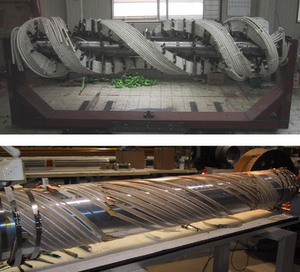Jan. 11, 2008 Research Highlight Physics / Astronomy
Snake-spin
High-energy protons with polarized spin can now be produced in particle colliders, thanks to devices called Siberian snakes
 Figure 1: Helically twisted magnets from the newly installed warm conducting (top) and cold superconducting (bottom) Siberian snake devices in the Alternating Gradient Synchrotron at Brookhaven National Laboratory. Copyright © Junpei Takano 2007
Figure 1: Helically twisted magnets from the newly installed warm conducting (top) and cold superconducting (bottom) Siberian snake devices in the Alternating Gradient Synchrotron at Brookhaven National Laboratory. Copyright © Junpei Takano 2007
The Relativistic Heavy Ion Collider (RHIC) at Brookhaven National Laboratory (BNL) in the US is the only particle collider in the world that can produce protons with polarized spin. Now researchers at BNL, Indiana University and the RIKEN Nishina Center for Accelerator-Based Science in Wako have improved the quality of these spin-polarized protons. Their work could help to uncover one of the great mysteries of particle physics—the origin of proton spin1.
The proton contains quarks, however the sum of the quark spins is not equal to the proton spin, explains project-member Junpei Takano. “To find the source of proton spin, we accelerate a polarized proton beam to high energy and analyze data from the collided beam.”
Before entering the RHIC, protons are accelerated in the Alternating Gradient Synchrotron (AGS), which uses magnetic fields to guide a beam of polarized protons around a circuit. However, at the same time, the protons undergo precession, or periodical changes in the direction of their axis of spin. If the frequency of precessions matches the frequency with which the protons encounter magnetic fields, the protons will resonate, causing them to lose their polarization.
To prevent these depolarizing resonances, the researchers have installed magnetic devices called Siberian snakes, which rotate the proton spin. The first snake used in the AGS—a solenoidal snake—removed some resonances but introduced a new ‘coupling resonance’ due to interactions between horizontal and vertical components of the beam.
RIKEN researcher Masahiro Okamura, who led the research and is now based at BNL, and Takano built a new type of snake magnet in 2004 that resolves a problem caused by the solenoidal snake2.
The new magnet uses a helically twisted coil (Fig. 1). Recently, another helical magnet with superconducting ‘cold’ coils was built at BNL. By carefully positioning the first ‘warm’ snake and the second ‘cold’ snake in the AGS, the researchers managed to accelerate a high energy beam of protons with 65% polarization.
In the RHIC itself, four similar snakes are used to keep high polarization. “The AGS had been the bottleneck of the polarization for the RHIC,” says Takano. “With the installation of the cold snake and the warm snake, the polarization of protons emerging from the AGS is increased.”
In future, the researchers hope to identify and overcome other sources of depolarization to boost the study of the proton spin structure that is producing increasingly intriguing results.
References
- 1. Huang, H., Ahrens, L.A., Bai, M., Brown, K., Courant, E.D., Gardner, C., Glenn, J.W., Lin, F., Luccio, A.U., MacKay, W.W., Okamura, M., Ptitsyn, V., Roser, T., Takano, J., Tepikian, S., Tsoupas, N., Zelenski, A. & Zeno, K. Overcoming depolarizing resonances with dual helical partial Siberian snakes. Physical Review Letters 99, 154801 (2007). doi: 10.1103/PhysRevLett.99.154801
- 2. Takano, J., Ahrens, L.A., Alforque, R., Bai, M., Brown, K., Courant, E.D., Ganetis, G., Gardner, C.J., Glenn, J.W., Hattori, T., Huang, H., Jain, A., Luccio, A.U., MacKay, W.W., Okamura, M., Roser, T., Tsoupas, N., Tepikian, S., Tuozzolo, J., Wood, J., Zelenski, A. & Zeno K. Helical dipole partial Siberian snake for the AGS. Journal of Instrumentation 11, 11002 (2006). doi: 10.1088/1748-0221/1/11/P11002
